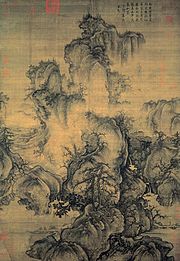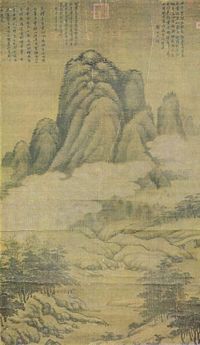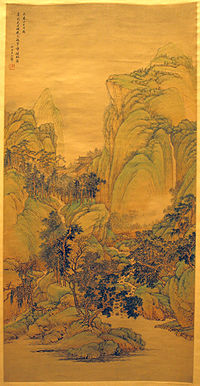
Shan shui
Encyclopedia




Chinese painting
Chinese painting is one of the oldest continuous artistic traditions in the world. The earliest paintings were not representational but ornamental; they consisted of patterns or designs rather than pictures. Early pottery was painted with spirals, zigzags, dots, or animals...
that involves or depicts scenery or natural landscape
Landscape art
Landscape art is a term that covers the depiction of natural scenery such as mountains, valleys, trees, rivers, and forests, and especially art where the main subject is a wide view, with its elements arranged into a coherent composition. In other works landscape backgrounds for figures can still...
s, using a brush
Ink brush
Ink brushes are used in Chinese calligraphy. They are also used in Chinese painting and descendant brush painting styles. The ink brush was invented in China, believed to be around 300BCE...
and ink
Ink
Ink is a liquid or paste that contains pigments and/or dyes and is used to color a surface to produce an image, text, or design. Ink is used for drawing and/or writing with a pen, brush, or quill...
rather than more conventional paints. Mountain
Mountain
Image:Himalaya_annotated.jpg|thumb|right|The Himalayan mountain range with Mount Everestrect 58 14 160 49 Chomo Lonzorect 200 28 335 52 Makalurect 378 24 566 45 Mount Everestrect 188 581 920 656 Tibetan Plateaurect 250 406 340 427 Rong River...
s, river
River
A river is a natural watercourse, usually freshwater, flowing towards an ocean, a lake, a sea, or another river. In a few cases, a river simply flows into the ground or dries up completely before reaching another body of water. Small rivers may also be called by several other names, including...
s and often waterfalls are prominent in this art form.
History
Shan shui painting first arose to prominence during the 5th century, in the reign of the Liu Song DynastyLiu Song Dynasty
The Liu Song Dynasty , also known as Song Dynasty , Former Song , or Southern Song , was first of the four Southern Dynasties in China, succeeding the Eastern Jin Dynasty and followed by the Southern Qi Dynasty....
. It was later characterized by a group of landscape painters such as Zhang Zeduan
Zhang Zeduan
Zhang Zeduan , alias Zheng Dao, also sometimes translated as Zhang Zerui, was a famous Chinese painter during the twelfth century, during the transitional period from the Northern Song to the Southern Song Dynasty, and was instrumental in the early history of the Chinese art style known as shan...
, most of them already famous, who produced large-scale landscape paintings. These landscape paintings usually centered on mountains. Mountains had long been seen as sacred places in China, which were viewed as the homes of immortals and thus, close to the heavens. Philosophical interest in nature, or in mystical connotations of naturalism
Naturalism (philosophy)
Naturalism commonly refers to the philosophical viewpoint that the natural universe and its natural laws and forces operate in the universe, and that nothing exists beyond the natural universe or, if it does, it does not affect the natural universe that we know...
, could also have contributed to the rise of landscape painting. The art of shan shui, like many other styles of Chinese painting has a strong reference to Taoist
Taoism
Taoism refers to a philosophical or religious tradition in which the basic concept is to establish harmony with the Tao , which is the mechanism of everything that exists...
(Daoist) imagery and motifs, as symbolisms of Taoism strongly influenced "Chinese landscape painting". Some authors have suggested that Daoist stress on how minor the human presence is in the vastness of the cosmos, or Neo-Confucian interest in the patterns or principles that underlie all phenomena, natural and social lead to the highly structuralized nature of shan shui.
Concepts
Most dictionaries and definitions of shan shui assume that the term includes all ancient Chinese paintings with mountain and water images. Contemporary Chinese painters, however, feel that only paintings with mountain and water images that follow specific conventions of form, style and function should be called "shan shui painting." When Chinese painters work on shan shui painting, they do not try to present an image of what they have seen in the nature, but what they have thought about nature. No one cares whether the painted colors and shapes look like the real object or not.According to Ch'eng Hsi:
Shan shui painting is a kind of painting which goes against the common definition of what a painting is. Shan shui painting refutes color, light and shadow and personal brush work. Shan shui painting is not an open window for the viewer's eye, it is an object for the viewer's mind. Shan shui painting is more like a vehicle of philosophy.
Compositions
Shan shui paintings involve a complicated and rigorous set of almost mystical requirements for balance, composition, and form. All shan shui paintings should have 3 basic components:Paths - Pathways should never be straight. They should meander like a stream. This helps deepen the landscape by adding layers. The path can be the river, or a path along it, or the tracing of the sun through the sky over the shoulder of the mountain.. The concept is to never create inorganic patterns, but instead to mimic the patterns that nature creates.
The Threshold - The path should lead to a threshold. The threshold is there to embrace you and provide a special welcome. The threshold can be the mountain, or its shadow upon the ground, or its cut into the sky. The concept is always that a mountain or its boundary must be defined clearly.
The Heart - The heart is the focal point of the painting and all elements should lead to it. The heart defines the meaning of the painting. The concept should imply that each painting has a single focal point, and that all the natural lines of the painting direct inwards to this point.
Elements and colors
Shan shui is painted and designed in accordance with Chinese elemental theory with five elementsFive elements (Chinese philosophy)
The Wu Xing, also known as the Five Phases, the Five Agents, the Five Movements, and the Five Steps/Stages, are chiefly an ancient mnemonic device, in many traditional Chinese fields....
representing various parts of the natural world, and thus has specific directions for colorations that should be used in 'directions' of the painting, as to which should dominate.
| Direction | Element | Colour |
|---|---|---|
| East | Wood | Green |
| South | Fire | Red |
| NE / SW | Earth | Tan or Yellow |
| West / NW | Metal | White or gold |
| North | Water | Blue or Black |
Positive interactions between the Elements are:
- Wood produces Fire
- Fire produces Earth
- Earth produces Metal
- Metal produces Water
- Water produces Wood.
Elements that react positively should be used together. For example, Water complements both Metal and Wood; therefore, a painter would combine blue and green or blue and white. There is a positive interaction between Earth and Fire, so a painter would mix Yellow and Red.
Negative interactions between the Elements are:
- Wood uproots Earth
- Earth blocks Water
- Water douses Fire
- Fire melts Metal
- Metal chops Wood
Elements that interact negatively should never be used together. For example, Fire will not interact positively with Water or Metal so a painter would not choose to mix red and blue, or red and white.
Connection to poetry
A certain movement in poetryChinese poetry
Chinese poetry is poetry written, spoken, or chanted in the Chinese language, which includes various versions of Chinese language, including Classical Chinese, Standard Chinese, Mandarin Chinese, Cantonese, Yue Chinese, as well as many other historical and vernacular varieties of the Chinese language...
, influenced by the shan shui style, came to be known as "shan shui poetry". Sometimes, the poems were designed to be viewed with a particular work of art, others were intended to be "textual art" that invoked an image inside a reader's mind.
Animation and film
The art form of shan shui has been popular to the point where a Chinese animationChinese animation
Chinese animation or Manhua Anime, in narrow sense, refers to animations that are made in China. In broad sense, it may refers to animations that are made in any Chinese speaking countries such as People's Republic of China , Republic of China , Hong Kong, Singapore, Malaysia, etc.- History :The...
from 1988 entitled Feeling from Mountain and Water
Feeling from Mountain and Water
Feeling from Mountain and Water is a Chinese animated short film produced by Shanghai Animation Film Studio under the master animator Te Wei. It is also referred to as "Love of Mountain and River", "Feelings of Mountains and Waters".-Background:The film did not contain any dialogue, allowing it...
uses the same art style and even the term for the film's title. Additionally, many recent movies and plays
Play (theatre)
A play is a form of literature written by a playwright, usually consisting of scripted dialogue between characters, intended for theatrical performance rather than just reading. There are rare dramatists, notably George Bernard Shaw, who have had little preference whether their plays were performed...
produced in China, specifically House of Flying Daggers
House of Flying Daggers
House of Flying Daggers is a 2004 wuxia film directed by Zhang Yimou. It differs from other wuxia films in that it is more of a love story than a straight martial arts film....
and Hero
Hero (2002 film)
Hero is a 2002 wuxia film directed by Zhang Yimou. Starring Jet Li as the nameless protagonist, the film is based on the story of Jing Ke's assassination attempt on the King of Qin in 227 BC....
, use elements of the style itself in the sets, as well as the elemental aspects in providing "balance".
Construction
The term shan shui is sometimes extended to include gardening and landscape designLandscape design
Landscape design is an independent profession and a design and art tradition, practised by landscape designers, combining nature and culture. In contemporary practice landscape design bridges between landscape architecture and garden design.-Design scope:...
, particularly within the context of feng shui
Feng shui
Feng shui ' is a Chinese system of geomancy believed to use the laws of both Heaven and Earth to help one improve life by receiving positive qi. The original designation for the discipline is Kan Yu ....
.
See also
- MoguMoguMogu , is a painting skill or technique in traditional Chinese painting. It literally means "boneless".-Derivation of the name:There are mainly two derivatives:...
- Blue-green shan shuiBlue-green shan shuiThe blue-green shan shui , is a Chinese painting style of "Shan shui". It tends to refer a "ancient style" rather than modern ones. The main colour of the painting are blues and greens, and in the early period it was painted by mineral dyes...
- Chinese artChinese artChinese art is visual art that, whether ancient or modern, originated in or is practiced in China or by Chinese artists or performers. Early so-called "stone age art" dates back to 10,000 BC, mostly consisting of simple pottery and sculptures. This early period was followed by a series of art...
- Wu Xing
- Ink and wash paintingInk and wash paintingInk and wash painting is an East Asian type of brush painting also known as ink wash painting. Only black ink — the same as used in East Asian calligraphy — is used, in various concentrations....
External links
- Chinese Landscape Painting at China Online Museum
- Chinese Painters and Galleries at China Online Museum

